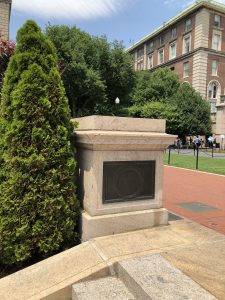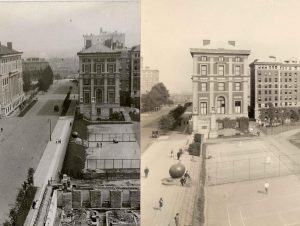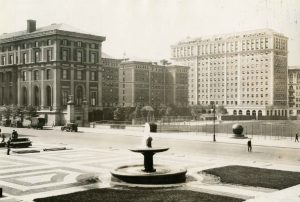If you stand by the Sundial and look towards Broadway, you will see an inscribed bronze tablet on the post of the College Walk railing. If you look towards Amsterdam, there is a matching tablet with a relief portrait on the other side’s post. This subtle, almost hiding-in-plain-sight, monument honors George Lockhart Rives – a Class of 1868 alum, who went on to serve as a Columbia trustee for 35 years, including 14 years as Chair of the Board.

George Lockhart Rives graduated second in his class in 1868, attended Trinity College, Cambridge, and then graduated from the Columbia Law School in 1873. Rives practiced mostly contract and estate law. An active citizen, he was counsel for and served on the Board of the New York Rapid Transit Commission, sorting out the legal questions of building the first subway lines. He was also president of the commission to revise the Greater New York Charter in 1900. When Seth Low became Mayor of the City of New York, Rives served as the first corporate counsel for the City. And while he served on Columbia’s Board of Trustees (1882-1917), he was also on the boards of the Astor Library, the Lenox Library, the New York Public Library and the New York Hospital.
During Rives’ tenure as Chair of the Trustees (1902-1917), he helped the University Council take on a greater role in the administration of the University. He also saw the small College he entered in 1864 with only 619 students grow into a large University with 21,752 students in 1917, his last year as trustee. When he resigned from the Board due to his health, he was immediately and unanimously awarded an honorary degree of Doctor of Laws in 1917 to mark his long and devoted service to Columbia.

In 1918, his widow Sara Whiting Belmont Rives wanted to mark Rives’ legacy on campus. The campus architects McKim, Meade and White gave Mrs. Rives a choice of potential monuments and she chose a balustrade along the south side 116th Street (then still open to traffic). The Class of 1885 Sundial, also designed by McKim, Meade and White, was already in place. This new campus feature was meant to connect Journalism and Hamilton Hall and to provide a new, graceful entrance to South Field, then an active athletics field with clay tennis courts. The Rives balustrade features two 60-foot long railings along College Walk, similar in style to those around Low Plaza. Instead of sitting atop a grassy slope (see the “before” or left half of the photo), the Sundial was now surrounded by 150-feet-wide granite steps (see the “after” or the right half of the photo). Finally, the Rives monument features two bronze plaques: one with an inscription noting his service to Columbia (on the west post) and one with a bas relief portrait by sculptor Ulysses Anthony Ricci (on the east post).
This is not the only monument on campus to George Lockhart Rives. In February 1920, a memorial plaque was unveiled inside St. Paul’s Chapel. There is also a large portrait of Rives by Adolfo Muller-Ury currently on display on the northwest corner of the third floor of Low Library.
